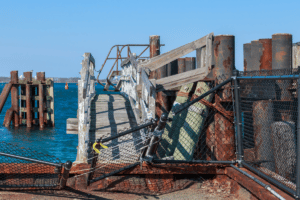Docks and piers are essential parts of every port facility. They provide mooring space for cruise ships and working vessels of all types and, as a consequence, are where many longshore and harbor workers perform their jobs. Docks and piers are filled with people, heavy equipment, and vehicles that are always on the move, thus they are among the most dangerous workplaces in the maritime industry. This hazardous environment is the scene of many accidents that injure or kill many longshore workers and other maritime employees every year.

Types of Dock and Pier Accidents
On land or at sea, maritime jobs are inherently dangerous no matter where they are performed. Maritime workers live and work in an environment that is full of hazards and unforgiving to even a momentary lapse of attention to detail or situational awareness. Docks and piers are almost as dangerous as shipyards or ships at sea because of the wide array of activities that take place around them. Ships’ crews require docks and piers to embark and disembark safely. Port workers must also use them to perform their various jobs, including longshore work, fueling vessels, and loading and unloading cargo.
Maritime jobs attract many people because they are lucrative, but they are physically and psychologically demanding, especially those that are done on docks and piers. They often involve the use of heavy machinery and the handling of dangerous materials in places where people and vehicles are constantly moving about. This mix of activities, workers and machines is bound to cause accidents. As a result, many maritime workers are seriously injured or killed each year in different types of accidents while working on docks and piers.
Some of the more common dock and pier accidents involve vehicular traffic. For instance, an inattentive truck driver may not notice that the loading process is still ongoing and pulls out of the loading dock just as a forklift attempts to put another load in the trailer. Though the truck is moving slowly, a gap appears between the forklift with its cargo and the rig’s trailer. The forklift then falls onto the roadway below the dock, suffering damage to the vehicle, the container, and the operator.
Other types of dock and pier accidents include:
- Crane and winch accidents
- Container accidents
- Electrocutions caused by improper placement of electrical wire and equipment
- Gangway accidents
- Structural collapse of wooden docks and piers caused by poor maintenance
- Truck, car, and forklift accidents
- Fires and explosions
- Accidents involving hazardous materials
- Slips, trips, and falls
- Mooring line accidents
- Collisions between vessels and piers
Although some accidents are caused by unforeseen circumstances, many are the result of negligence on the part of facility operators or employers who overlook safety procedures or fail to train workers properly. Employers can also be at fault if they force seamen and longshore workers to work too many hours without regard for their safety just to meet an ambitious deadline. Additionally, companies that allow docks and piers to deteriorate instead of repairing or replacing rotted wood or crumbling concrete fail to fulfill an obligation to provide workers with a safe place of employment.
Keep in mind that if you’ve been injured due to the negligence of another party, you may entitled to damages. For more information, see our article Maritime Rights and Compensation.